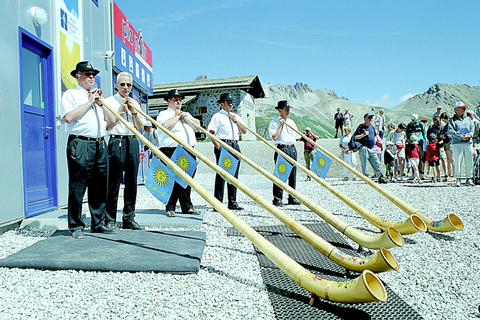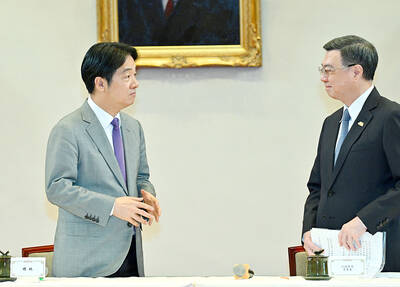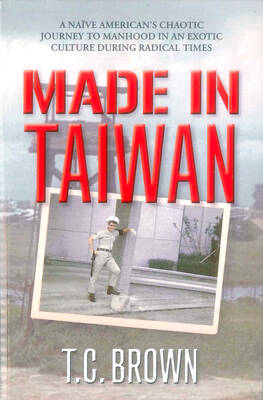If you're going to imagine a stereotypical Swiss person, you may think of someone with an alphorn, due to all the Swiss connotations that it possesses. So tonight in Taipei, alphorn fans and Swissophiles will be given the rare chance to witness the alphorn in action when the Alphorn Ensemble Engiadina plays at the German Cultural Center.
The alphorn (also known as the alpenhorn) is a long, narrow wind instrument that curves up and flares out at the end. The wooden instrument was developed nearly 2,000 years ago by Celtic tribes living on the northern slopes of the Alps and was used to calm the dairy cows at milking time and to signal the twilight, when shepherds would bring their sheep in for the night.
The alphorn came to be an important part of alpine culture and was a mainstay of meetings and festivals. Craftsmen used to look for trees curved at the base from which to carve their alphorns, but nowadays the base is made from a separate piece of wood. With a simple design and time-tested dimensions, the alphorn is capable of producing powerful, reverberating notes with a range of three octaves, despite its lack of lateral holes. Although alphorn music is characterized by long, arching tones, some players are capable of amazing virtuosity.

PHOTO COURTESY OF GERMAN CULTURAL CENTER
The Alphorn Ensemble Engiadina hails from St Moritz/Engadin in southeastern Switzerland. The group was put together informally in 1988, playing now and again at parties. The six-member group, which includes a tourism board director, two policemen and three retirees, solidified in 1992 and became affiliated with the St. Moritz summer and winter resort.
Today the ensemble plays for television and film production. They even hold their own annual Alphorn Day in Engadin. They have made trips to Vail, Colorado, where they played at the 2000 World Cup Ski Racing, and to Asia, making stops in Singapore, Kuala Lumpur, Ho Chi Minh City and now Taipei.
Trade Office of Swiss Industries Deputy Director Enrico Pianta met the group's leader Hanspeter Danuser when the two were working for Swiss tourism in Dubai, UAE. "I knew that the group had been invited to the World Expo in Aichi, so I got in touch and asked them why not stop in Taipei ? we would be very happy to have them hear and be able to give Taipei a little hint of Swiss culture and heritage," he said. The ensemble's visit is perfect timing because Switzerland's national day is just around the corner on Monday.
Swiss National Day was created in 1899 to commemorate the Rutli Oath, Switzerland's founding act. In the summer of 1291, representatives from the cantons of Uri, Schwyz and Unterwalden joined together to found the Swiss Federation. The day is traditionally celebrated with communal meals, patriotic speeches, singing, gymnastics and of course alphorn playing.
Besides their 7pm performance at the German Cultural Center tonight, the Alphorn Ensemble Engiadina will be playing at Taipei 101 for the Swiss Alphorn Festival tomorrow at 2:30pm, which also includes an activity for audience members to try out the alphorn. Both performances are free. The group will also take part in the invitation-only Swiss National Day Celebration at the Far Eastern Hotel tomorrow night.
The German Cultural Center is at 12F, 20 Heping W Rd, Sec1, Taipei (台北市和平東路一段20號12樓).

Under pressure, President William Lai (賴清德) has enacted his first cabinet reshuffle. Whether it will be enough to staunch the bleeding remains to be seen. Cabinet members in the Executive Yuan almost always end up as sacrificial lambs, especially those appointed early in a president’s term. When presidents are under pressure, the cabinet is reshuffled. This is not unique to any party or president; this is the custom. This is the case in many democracies, especially parliamentary ones. In Taiwan, constitutionally the president presides over the heads of the five branches of government, each of which is confusingly translated as “president”

By 1971, heroin and opium use among US troops fighting in Vietnam had reached epidemic proportions, with 42 percent of American servicemen saying they’d tried opioids at least once and around 20 percent claiming some level of addiction, according to the US Department of Defense. Though heroin use by US troops has been little discussed in the context of Taiwan, these and other drugs — produced in part by rogue Chinese Nationalist Party (KMT) armies then in Thailand and Myanmar — also spread to US military bases on the island, where soldiers were often stoned or high. American military policeman

An attempt to promote friendship between Japan and countries in Africa has transformed into a xenophobic row about migration after inaccurate media reports suggested the scheme would lead to a “flood of immigrants.” The controversy erupted after the Japan International Cooperation Agency, or JICA, said this month it had designated four Japanese cities as “Africa hometowns” for partner countries in Africa: Mozambique, Nigeria, Ghana and Tanzania. The program, announced at the end of an international conference on African development in Yokohama, will involve personnel exchanges and events to foster closer ties between the four regional Japanese cities — Imabari, Kisarazu, Sanjo and

The Venice Film Festival kicked off with the world premiere of Paolo Sorrentino’s La Grazia Wednesday night on the Lido. The opening ceremony of the festival also saw Francis Ford Coppola presenting filmmaker Werner Herzog with a lifetime achievement prize. The 82nd edition of the glamorous international film festival is playing host to many Hollywood stars, including George Clooney, Julia Roberts and Dwayne Johnson, and famed auteurs, from Guillermo del Toro to Kathryn Bigelow, who all have films debuting over the next 10 days. The conflict in Gaza has also already been an everpresent topic both outside the festival’s walls, where